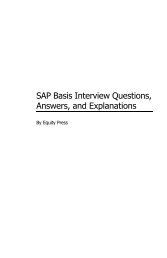Hardware and Operating System SAP R/3 Basis ... - SAP Techies
Hardware and Operating System SAP R/3 Basis ... - SAP Techies
Hardware and Operating System SAP R/3 Basis ... - SAP Techies
Create successful ePaper yourself
Turn your PDF publications into a flip-book with our unique Google optimized e-Paper software.
Introduction To <strong>SAP</strong> R/3 <strong>Basis</strong><br />
-----------------------------------------------------------<br />
Roll-In/Roll-Out Processing<br />
An ABAP/4 program only occupies a work process for one dialog step. At<br />
the beginning of the dialog step, the roll area <strong>and</strong> user context are rolled in<br />
to the work process. At the end of the dialog step, they are rolled out.<br />
During the roll-in, pointers to the roll area <strong>and</strong> user context are populated in<br />
the work process. This enables the work process to access the data in those<br />
areas <strong>and</strong> so perform processing for that user <strong>and</strong> that program. Processing<br />
continues until the program sends a screen to the user. At that time, both<br />
areas are rolled out. Roll-out invalidates the pointers <strong>and</strong> disassociates these<br />
areas from the work process. That work process is now free to perform<br />
processing for other requests. The program is now only occupying memory,<br />
<strong>and</strong> not consuming any CPU. The user is looking at the screen that was sent,<br />
<strong>and</strong> will soon send another request.<br />
When the next request is sent from the user to continue processing, the<br />
dispatcher allocates that request to the first available work process. It can be<br />
the same or a different work process. The user context <strong>and</strong> roll area for that<br />
program are again rolled in to the work process, <strong>and</strong> processing resumes<br />
from the point at which it was left off. Processing continues until the next<br />
screen is shown, or until the program terminates. If another screen is sent,<br />
the areas are again rolled out. When the program terminates, the roll area is<br />
freed. The user context remains allocated until the user logs off.<br />
In a system with many users running many programs, only a few of those<br />
programs will be active in work processes at any one time. When they are<br />
not occupying a work process, they are rolled out to extended memory <strong>and</strong><br />
only occupy RAM. This conserves CPU <strong>and</strong> enables the R/3 system to<br />
achieve high transaction throughput.<br />
Compiled By: Ashwin Vavaiya 18 of 44



